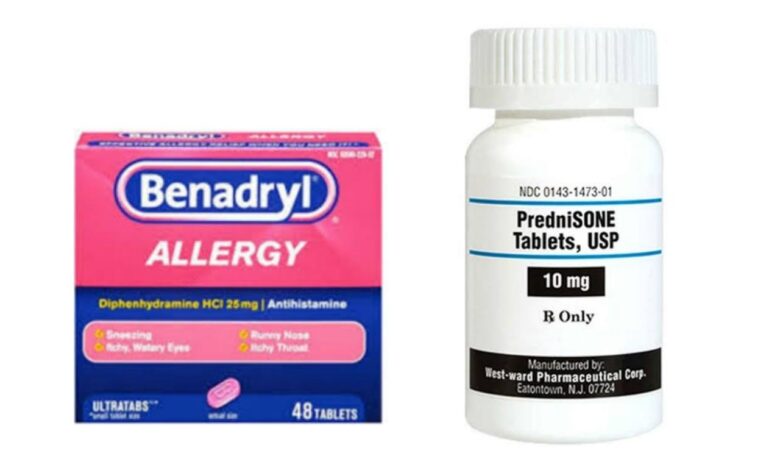Can You Take Benadryl With Prednisone Together?

Mixing any combination of prescription drugs, over-the-counter drugs can be unpredictable and dangerous. Most fatal overdoses involve the use of more than one type of drug (poly-drug use).
Poly-drug use is dangerous because different drugs act on our bodies in different ways. The harmful effects are magnified by using more than one drug type.
What is Benadryl?
Benadryl is a brand of diphenhydramine, an over-the-counter medication that is classified as an antihistamine. It’s used to help relieve symptoms of hay fever (seasonal allergies), other allergies, and the common cold, as well as itchy skin due to insect bites, hives, and other causes.
Benadryl is effective for decreasing itchy skin from hives. It’s often considered a first-choice treatment for hives. But although it’s effective for decreasing symptoms of seasonal allergies, Benadryl isn’t often used for this purpose. This is due to side effects such as sleepiness. Benadryl comes in many different forms. Some are oral (taken by mouth), and some are topical (applied to the skin).
What is Prednisone?
Prednisone is used alone or with other medications to treat the symptoms of low corticosteroid levels (lack of certain substances that are usually produced by the body and are needed for normal body functioning). Prednisone is also used to treat other conditions in patients with normal corticosteroid levels. These conditions include certain types of arthritis; severe allergic reactions; multiple sclerosis (a disease in which the nerves do not function properly); lupus (a disease in which the body attacks many of its own organs); and certain conditions that affect the lungs, skin, eyes, kidneys blood, thyroid, stomach, and intestines. Prednisone is also sometimes used to treat the symptoms of certain types of cancer. Prednisone is in a class of medications called corticosteroids. It works to treat patients with low levels of corticosteroids by replacing steroids that are normally produced naturally by the body. It works to treat other conditions by reducing swelling and redness and by changing the way the immune system works.
Can you take Benadryl with prednisone?
Yes, many physicians prescribe Benadryl and prednisone together for the treatment of allergies. However, a newly published study warns that the use of prednisone with medications like Benadryl can complicate relief and make recovery time longer.
How should Benadryl be used?
Benadryl comes as a tablet, a rapidly disintegrating (dissolving) tablet, a capsule, a liquid-filled capsule, a dissolving strip, powder, and a liquid to take by mouth. When diphenhydramine is used for the relief of allergies, cold, and cough symptoms, it is usually taken every 4 to 6 hours. When diphenhydramine is used to treat motion sickness, it is usually taken 30 minutes before departure and, if needed, before meals and at bedtime.
When Benadryl is used to treat insomnia, it is taken at bedtime (30 minutes before planned sleep). When diphenhydramine is used to treat abnormal movements, it is usually taken three times a day at first and then taken 4 times a day. Follow the directions on the package or on your prescription label carefully, and ask your doctor or pharmacist to explain any part you do not understand. Take diphenhydramine exactly as directed. Do not take more or less of it or take it more often than prescribed by your doctor or directed on the label
How should prednisone be used?
Prednisone comes as a tablet, delayed-release tablet, as a solution (liquid), and as a concentrated solution to take by mouth. Prednisone is usually taken with food one to four times a day or once every other day. Your doctor will probably tell you to take your dose(s) of prednisone at a certain time(s) of the day every day. Your personal dosing schedule will depend on your condition and on how you respond to treatment. Follow the directions on your prescription label carefully, and ask your doctor or pharmacist to explain any part you do not understand. Take prednisone exactly as directed. Do not take more or less of it or take it more often or for a longer period of time than prescribed by your doctor.
If you are taking the concentrated solution, use the specially marked dropper that comes with the medication to measure your dose. You may mix the concentrated solution with juice, other flavored liquids, or soft foods such as applesauce.
Swallow the delayed-release tablet whole; do not chew or crush it.
Your doctor may change your dose of prednisone often during your treatment to be sure that you are always taking the lowest dose that works for you. Your doctor may also need to change your dose if you experience unusual stress on your body such as surgery, illness, infection, or a severe asthma attack. Tell your doctor if your symptoms improve or get worse or if you get sick or have any changes in your health during your treatment.
If you are taking prednisone to treat a long-lasting disease, the medication may help control your condition but will not cure it. Continue to take prednisone even if you feel well. Do not stop taking prednisone without talking to your doctor. If you suddenly stop taking prednisone, your body may not have enough natural steroids to function normally. This may cause symptoms such as extreme tiredness, weakness, slowed movements, upset stomach, weight loss, changes in skin color, sores in the mouth, and craving for salt. Call your doctor if you experience these or other unusual symptoms while you are taking decreasing doses of prednisone or after you stop taking the medication.





